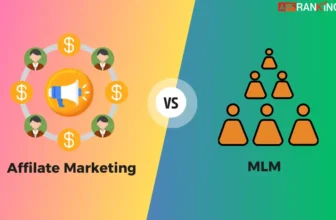As a publisher, you're always on the lookout for tools or platforms that can optimize your operations and maximize your revenue. And when it comes to ad servers, the stakes are incredibly high.
Did you know that the right ad server can increase your ad revenue by up to 50%? Yes, you read that right. The best ad servers for publishers are not just platforms, they are game-changers. They offer a comprehensive suite of features that make managing ad campaigns effortless, while also providing extensive reporting capabilities that give you insights into your audience's behavior.
From Google Ad Manager, renowned for its extensive features and real-time support, to Smart Ad Server, known for its programmatic and direct campaign capabilities, the options are numerous.
But how do you choose the one that's right for you? 🤔
After understanding the kind of hassle that a marketer has to go through while choosing the best ad server, I have curated an article that will not only cover all the important aspects but will also include some in-depth insights that might help you in choosing your “One and Only”Ad server.
But before we move ahead with the list of best ad servers for publishers, let's have a quick overview of what an ad server is.
What is an Ad Server?
An ad server is a technology platform that manages and delivers advertisements to digital spaces such as websites, mobile apps, and social media platforms. It plays a crucial role in the online advertising ecosystem by storing ad content, selecting ads based on various criteria, serving them to the designated spaces, and tracking the performance of these ads including metrics such as impressions, clicks, and conversions.
Ad servers can be used by both publishers, to sell their ad space, and advertisers, to buy and manage ad placements. They provide a centralized tool for managing ad campaigns across multiple channels, enabling users to optimize their advertising strategies based on real-time data.
🗼 Best Ad Servers for Publishers
Here is a list of the 10 best ad servers for publishers that can help in making your business and marketing operations much better to a great extent, so without any further delay let's get started!!
#1 Magnite
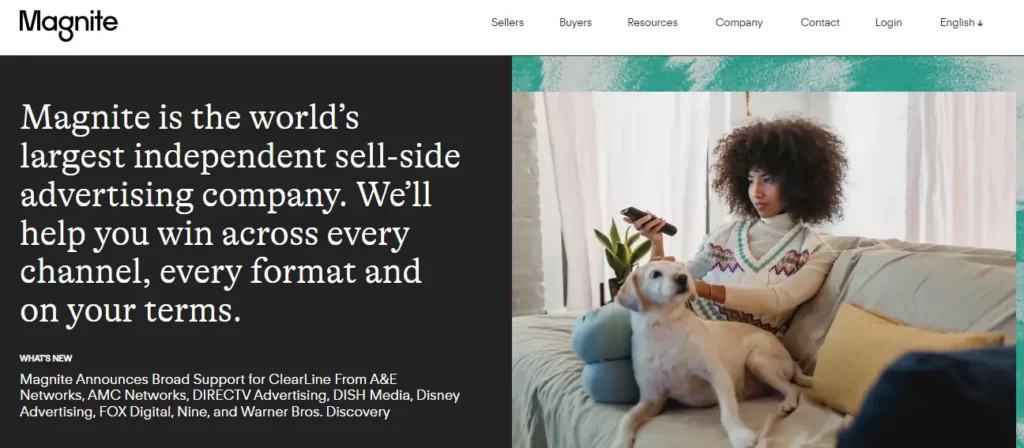
Magnite has acquired quite a great name in the world of ad servers and stands tall as the #1 choice for publishers. With an impressive number of advertisers and publishers, Magnite has become quite a popular choice across other ad servers in the list.
Magnite's real-time customized reporting feature allows publishers to get ahead with great opportunities that they might encounter. With responsive alerts and an intuitive insights dashboard, publishers can take benefits from the data-driven insights offered. On the positive side, Magnite also offers an excellent service, starting from setup to yield optimization, Magnite's team of experts provides comprehensive support. They guide publishers through every step of the way, ensuring a seamless and efficient ad management experience.
Magnite Key Features
- The Real-Time Customized Reporting feature provides publishers with responsive alerts and an intuitive insights dashboard. It allows for real-time tracking of ad performance, enabling publishers to make quick, data-driven decisions that can enhance their ad campaigns.
- Magnite's Ad Pod Control feature offers tools for effective inventory management. It helps publishers maximize the performance and revenue for every available ad by optimizing the placement and timing of ads.
- With the rise of live streaming, Magnite leverages innovative technologies to create new revenue generation opportunities. Publishers can monetize their live streams effectively, reaching their audience in real-time.
- Audience Management Feature allows publishers to control, curate, connect, and safeguard their audience enablement data. It ensures that the audience's preferences and behaviors are at the heart of the publisher's strategy, leading to more personalized and effective ad campaigns.
- As co-founders of Prebid.org, Magnite offers turnkey wrapper management and yield optimization. This association ensures that publishers have access to a community-driven, future-proof, and transparent platform for their ad operations.
- Magnite is built on the foundation of Prebid, an open-source platform. This ensures transparency and adaptability, allowing publishers to benefit from the collective advancements of the community.
- Magnite provides intuitive user interfaces and real-time analytics for easy configuration and optimization of headers. This simplifies the process of header bidding, making it more accessible to publishers.
- Magnite offers publishers access to its brand-safe marketplace through an open auction, private, and guaranteed deals. This integration provides publishers with a wide range of options for their ad placements.
#2 Equativ (formerly known as Smart Ads Server)
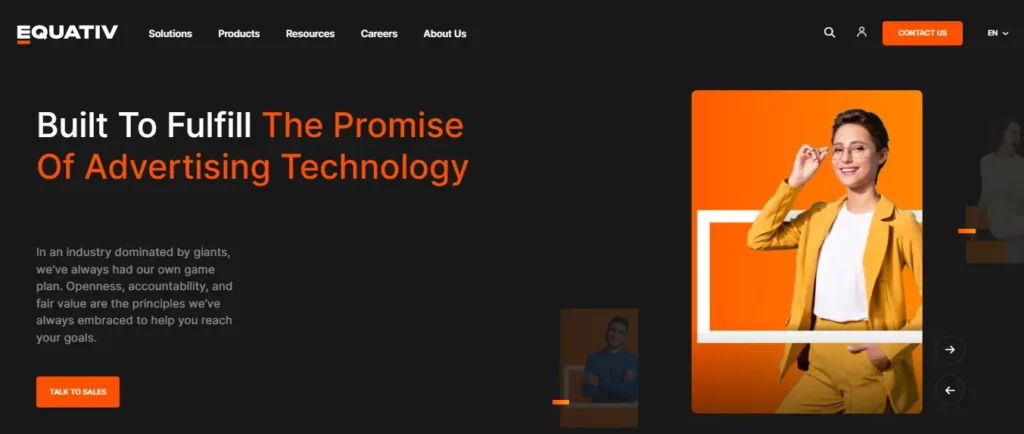
Securing the 2nd place on our list, Equativ has been in the industry for around 17 years, which is quite an excellent thing to look forward to. With its global reach and direct access to premium demand through top DSP, agency, and curation partners, Equativ has acquired quite a special spot on our list.
On the other hand, Equativ's Supply Side Platform (SSP) is designed to ensure that publishers get their fair share of the advertising pie. It offers easy integration and a complete range of monetization capabilities, from in-app to desktop to Connected TV (CTV). With Equativ, you can develop a strategy to drive revenue across all platforms.
Equativ Key Features
- Equativ's SSP provides publishers with global reach and direct access to premium demand. This is made possible through partnerships with top Demand Side Platforms (DSPs), agencies, and curation partners.
- Equativ offers a complete range of monetization capabilities that are easy to integrate. Whether you're looking to monetize in-app, desktop, or Connected TV (CTV) platforms, Equativ has got you covered.
- With Equativ, publishers have complete control over their content, audiences, and data. The integrated and flexible ad management platforms offered by Equativ ensure that publishers can optimize their yield and operational efficiency.
- Equativ's award-winning ad server, coupled with its connections and direct access to premium demand partners, helps in increasing your revenue to a better extent.
#3 Google Ad Manager

Now we have got Google Ad Manager as #3 on our list, Google Ad Manager (GAM) stands tall as a leading choice for publishers. Garnering billions of impressions daily, this platform has become a cornerstone for many businesses, small and large alike. It's a comprehensive solution that offers a whole lot of features designed to streamline ad management and maximize revenue.
GAM, a rebranded amalgamation of Google's advertising products, including Ad Exchange, offers an excellent suite of features. These features are designed to cater to the diverse needs of publishers, from small businesses to premium publishers.
GAM offers two versions to cater to different user needs. The first version, designed for small businesses, is free of charge and provides a comprehensive set of tools to get started with ad management. The second version, aimed at premium publishers, offers advanced features and tools to manage large volumes of traffic and revenue. This version is particularly beneficial for publishers with websites generating over 5 million page views or earning more than $5000 per month.
Google Ad Manager Key Features
- Ad Exchange dynamic allocation helps in running a good analysis with real-time competition between direct-sold ads and those from the Ad Exchange. The system automatically allocates the ad space to the highest bidder, ensuring that you get the maximum possible revenue for each ad impression.
- Google Ad Manager provides a user-friendly interface with intuitive dashboards that make it easy to manage your ad campaigns. The reporting feature is comprehensive, providing insights into ad performance, user engagement, and revenue generation. These reports can be customized to focus on the metrics that matter most to your business.
- Google Ad Manager supports a wide range of ad formats, including text, image, video, and rich media, giving you the flexibility to choose the formats that best suit your content and audience. It also supports various pricing models such as cost-per-click (CPC), cost-per-thousand-impressions (CPM), and cost-per-action (CPA), allowing you to monetize your content in the way that works best for you.
- Backed by Google's infrastructure, Google Ad Manager guarantees high uptime and consistent performance. It can handle large volumes of traffic and deliver ads quickly and efficiently, ensuring a smooth user experience. Moreover, Google's advanced security measures protect against ad fraud and ensure that your data is safe.
#4 Broadstreet
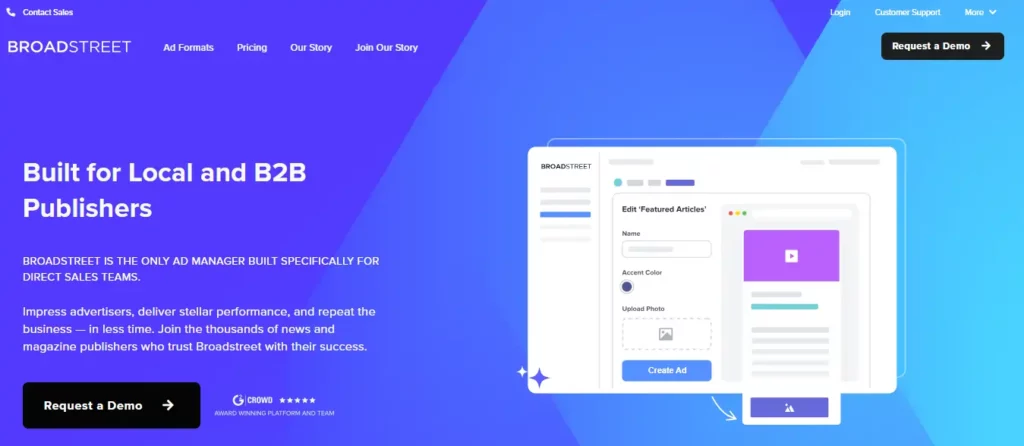
Securing the sweet spot at #4 in our list of best ad servers for publishers, Broadstreet is particularly well-suited for small to medium-sized businesses, local news outlets, and magazine-styled sites that focus on direct sales. For niche publishers, Broadstreet can be the perfect fit, helping them provide maximum value to their advertisers, thereby improving efficiency and overall performance.
Broadstreet is the perfect solution for publishers who have found themselves spending precious time on tasks such as creating performance reports, manually inserting ads into newsletters, or searching for a single sponsored post report in Google Analytics. It's also a lifesaver for those who have had to explain to a frustrated client why their ad is at the bottom of the page on a mobile device, or why they should be satisfied with the number of clicks they received.
Broadstreet Key Features
- Broadstreet is designed with user-friendliness in mind. If you've previously used platforms like Google Ad Manager or OpenX, you'll find Broadstreet's interface familiar and easy to navigate. This ease of use extends to all aspects of the platform, from ad creation and placement to reporting and analytics.
- Broadstreet takes the hassle out of reporting. The platform automatically generates detailed performance reports for your advertisers, saving you the time and effort of manual report creation. These reports provide valuable insights into ad performance, helping advertisers understand the value they're getting from their ads.
- Broadstreet provides in-depth analytics for your sponsored content. This feature allows you to track the performance of your sponsored posts, providing insights into metrics like views, clicks, and conversions. These insights can help you optimize your sponsored content strategy and maximize your revenue.
- With Broadstreet, managing ads in your newsletters becomes a breeze. The platform allows you to manage your newsletter ads directly from your dashboard, eliminating the need for manual ad insertion. This feature can save you significant time and effort, especially if you send out newsletters regularly.
- Broadstreet offers a white labeling option, allowing you to present the platform as your own to your clients. This feature can enhance your brand image and provide a more seamless experience for your clients. With white labeling, your clients will see your branding on the platform, not Broadstreet's.
#5 AdButler
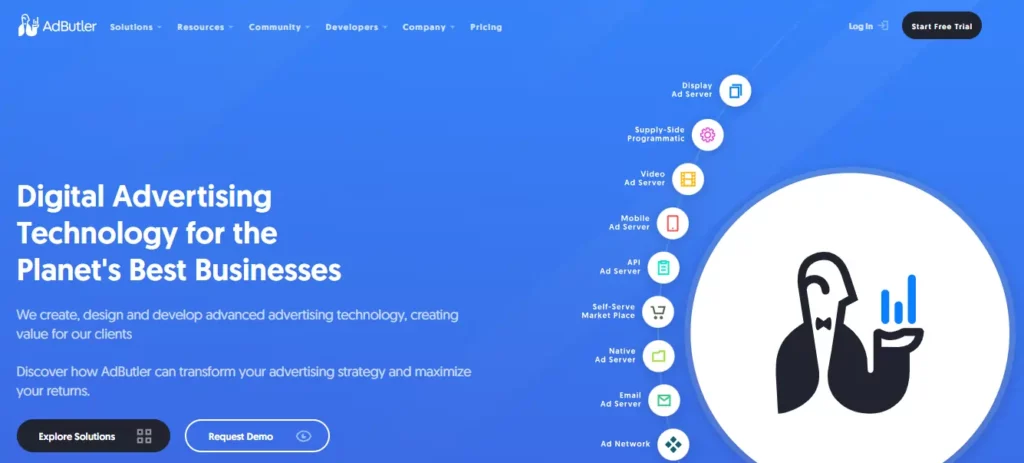
As we continue our exploration of top-tier ad server platforms, we arrive at the 5th entry on our list, AdButler. With a reputation for delivering billions of impressions, AdButler is a comprehensive ad server solution that caters to a diverse range of publishers. It's a platform that's been trusted by industry giants such as Costco, Pattison Media, Variety, and Hagerty.
AdButler offers a complete suite of features designed to maximize revenue, save time, and reduce costs for publishers. It's a full-stack ad server that supports display ad serving, email, video, mobile, digital out-of-home, self-serve marketplaces, order management, APIs, and custom development. AdButler's white-labeling option lets you create an ad server that aligns with your unique brand identity, incorporating your specific branding elements and color palette. You can even get a white-labeled domain and sign up to your ad server with a familiar URL. AdBulter also offers some customized tech developments which cater to the unique requirement that you might be having.
AdButler Key Features
- AdButler supports a wide range of ad server types, including Display, API, Native, Video, Email, Mobile, and Digital Out-of-Home Ad Servers. This diversity allows publishers to serve ads across multiple platforms and formats, ensuring a broad reach and effective audience engagement.
- AdButler's self-hosted ad servers automate the sales process, making it easy for advertisers to purchase and manage their ads. This feature not only saves time but also enhances the user experience for advertisers.
- AdButler unlocks new revenue opportunities for retail and e-commerce businesses through sponsored products. This feature allows businesses to promote their products directly within their online store, enhancing visibility and driving sales.
- AdButler allows you to create an ad server that reflects your brand. You can customize the look and feel of the platform with your branding and color scheme, and even use a white-labeled domain for a familiar URL.
- AdButler's team of skilled AdTech developers can provide custom solutions tailored to your unique needs.
#6 Epom
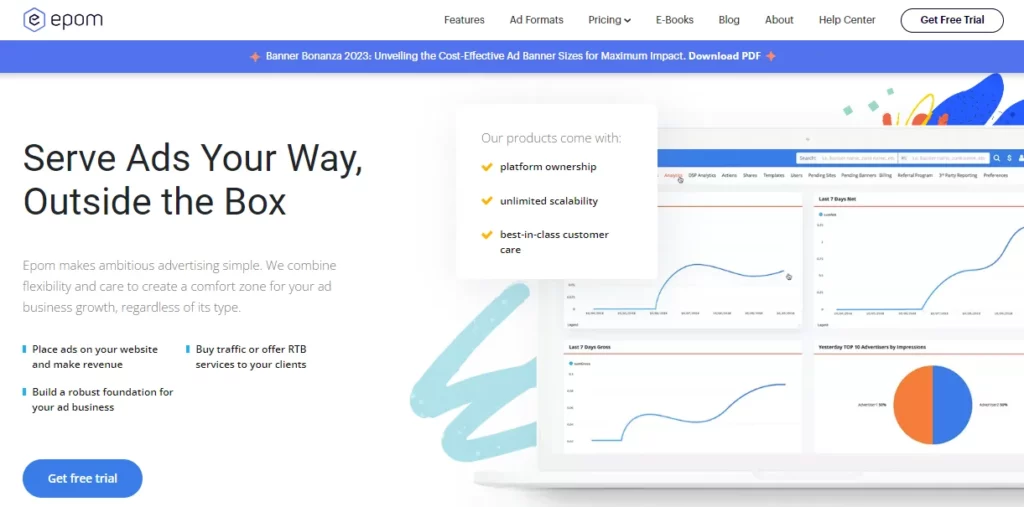
With over 10 years of experience in the industry and billions of ad impressions, Epom is a trusted partner for publishers seeking to optimize their ad campaigns and maximize their revenue. On the other hand, Epom also offers more than 800 customizable features for publishers and has been awarded the MarTech breakthrough award in 2019.
Epom's platform is particularly advantageous for publishers, offering over 50 pre-set rich media templates, advanced analytics with multidimensional custom reporting, white labeling, a flexible role management system, and custom feature development. Publishers are provided with the choice to market traffic via RTB and combine their software with Epom's white-label DSP as part of a bundled solution.
Epom Key Features
- Epom provides access to premium ad inventory, enabling publishers to reach their target audience across various devices. Whether it's mobile, desktop, video, or in-app, Epom ensures your ads reach the right users, eliminating wasted ad spending and discrepancies.
- Epom Ad Server offers a fully customizable interface that can be tailored to match your brand's look and feel. This feature allows you to maintain brand consistency while leveraging Epom's ad-serving capabilities.
- Epom provides in-depth insights into your campaign performance. From global audience outreach to individual ad conversion rates, Epom's automatic CTR, conversion, and eCPM optimization simplifies your ad operations and facilitates split testing directly within your account.
- Epom's advanced algorithms help you optimize CTR, I2C, and eCPM to meet your desired KPIs. Get a complete real-time overview of your performance with just a few clicks and discover insights that will help your business grow.
#7 OpenX
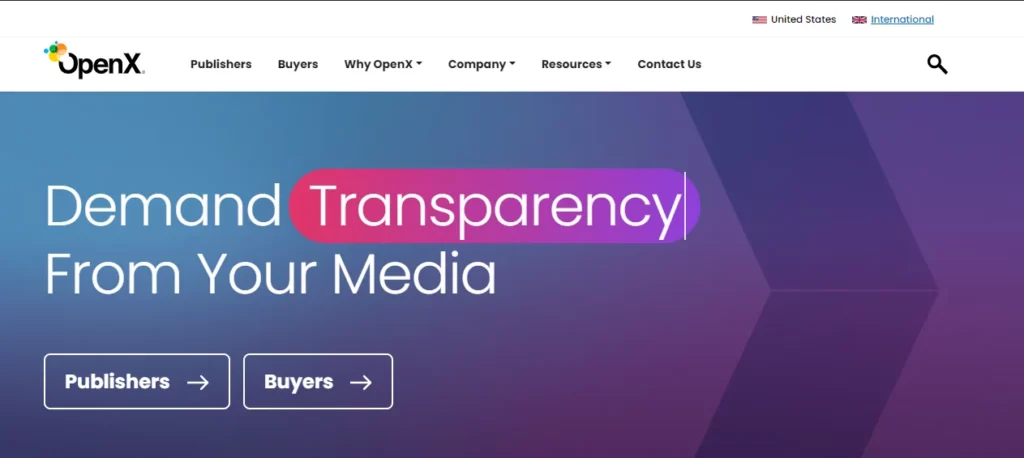
Being listed at the 7th position in our list OpenX has emerged as a popular ad server among publishers. With a decade-long presence in the market, OpenX has established itself as a trusted partner for publishers, closing deals with some of the world's largest marketers, partnering with DSPs, and expanding relationships with global holding companies.
One of the standalone features worth mentioning is that OpenX leverages its advanced technology to provide publishers with deep insights into their users, thereby driving more revenue. Their suite of products allows publishers to leverage OpenX's identity graph, offering a more comprehensive understanding of user behavior.
OpenX Key Features
- OpenX's enduring relationships with agencies and brands, custom SPO arrangements, and identity-based activation partners contribute to its preferred SSP status. These long-term partnerships drive demand and increase yield for publishers.
- OpenX works closely with buyers to create unique exchange packages tailored to their specific audiences. This strategy not only drives results for the buyers but also generates increased revenue for publishers.
- OpenX's ID resolution feature matches site visitor data to third-party identifiers, creating a unified, resolved view of users. This feature enables publishers to better understand their audience and tailor their content accordingly.
- OpenX empowers publishers to create their own audiences. By working with buyers to create packaged deals focused on specific audiences, OpenX ensures that the results drive revenue for both parties.
#8 Xandr (AppNexus)

Xandr which is now currently been now acquired from Microsoft has been a popular choice among publishers. Xandr's built-in Marketplace, SSP, and ad server provide a comprehensive solution for publishers, allowing them to manage all their advertising activities in one place. Their publisher platforms, including Monetize SSP, Monetize Ad Server, and Yield Analytics, unlock the full value of your inventory and improve the experience for your consumers.
Xandr's industry-leading forecasting analytics tool uses data from the past two years to provide accurate yield estimates and inventory availability, offering superior forecasting compared to its competitors. With support for video, display, and native ads, and compatibility with all screen sizes, the platform offers publishers a wide range of flexibility in ad delivery. Additionally, Xandr's open dynamic allocation feature allows programmatic demand to compete against direct deals, ensuring optimal yield for publishers.
Xandr Key Features
- Xandr's ad server supports a wide range of ad formats including video, display, and native. This versatility allows publishers to serve ads across all screen sizes, from mobile devices to desktop computers.
- One of the standout features of Xandr is its open dynamic allocation. This feature allows your programmatic demand to compete against direct deals. In other words, it ensures that every ad impression is sold to the highest bidder, whether they're coming from programmatic channels or direct deals.
- Xandr comes with a built-in Supply Side Platform (SSP). An SSP is software used by publishers to sell display, video, and mobile ads programmatically. This means that publishers can manage their ad impression inventory and make it available to ad exchanges where it can be bought by marketers.
- Xandr provides premium support to its users. This means that if you encounter any issues or have any queries about using the platform, you can expect prompt and helpful assistance from their support team.
#9 Kevel
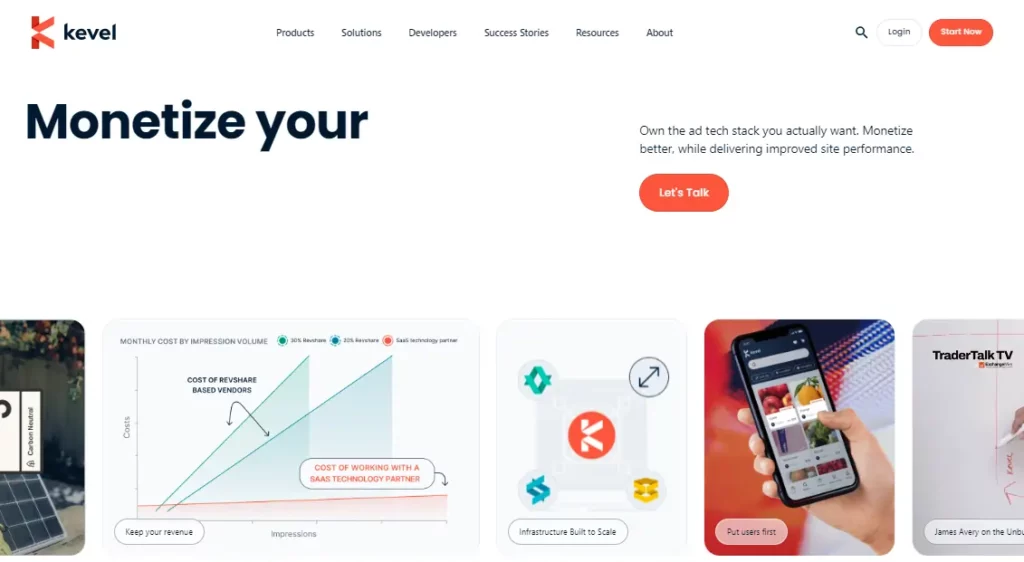
Kevel, previously known as Adzerk, stands out as a premier choice among the best ad servers for publishers. Serving billions of impressions each month, Kevel offers an extensive suite of APIs that allows publishers to build their own ad servers.
This unique approach of building your own ad server provides publishers with full control over their ad server, including features such as server-side ad serving for fast response times, JSON API responses for flexible ad creation, first-party data management for user-level targeting, and custom revenue and auction pricing rules. With these powerful tools, Kevel is transforming the way publishers manage and monetize their digital content.
Kevel Key Features
- Kevel's server-side ad serving ensures rapid ad delivery, with response times as low as 50ms. This feature also enables the monetization of ad block users, ensuring that no revenue opportunity is missed.
- Kevel's JSON API responses offer the flexibility to transform any organic content into an ad. This feature allows publishers to monetize various types of content, such as search results, articles, or even recipes.
- Kevel provides turnkey access to a first-party data management platform. This feature enables user-level targeting, allowing publishers to deliver more relevant ads to their audience.
- Kevel allows publishers to set custom revenue logic and auction pricing rules. This feature provides full control over monetization, enabling publishers to maximize their ad revenue.
- Kevel allows publishers to control ad delivery with pacing, targeting, and relevancy scoring. This feature ensures that the right ads are delivered to the right audience at the right time.
#10 Revive Adserver
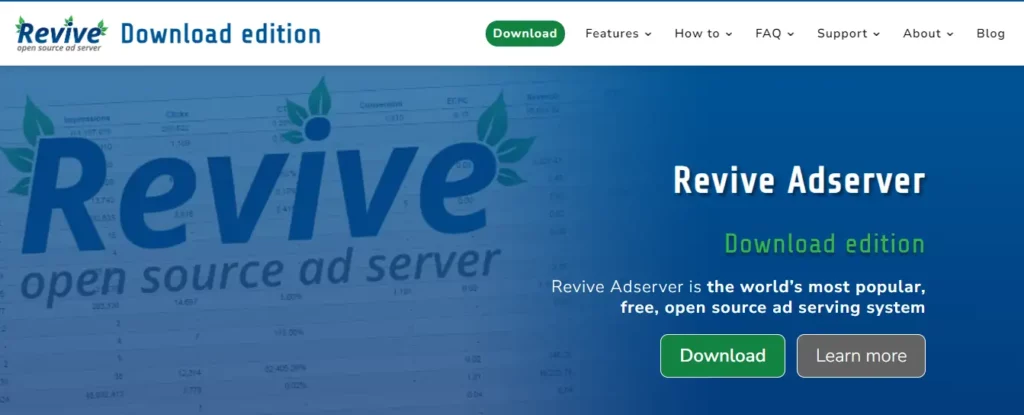
Rounding off at #10, Revive Adserver has secured the last spot in our list of best ad servers for publishers. With a hosted option starting at just $10 per month, Revive Adserver provides an affordable yet robust platform that enables publishers to serve ads on websites, in apps, and in video players, manage campaigns for multiple advertisers and ad networks, define delivery rules for campaigns and ads, and track campaign performance with detailed statistics.
Revive Adserver Key Features
- Revive Adserver enables the serving of ads on websites, in apps, and in video players. It also collects detailed statistics, including impressions, clicks, and conversions, providing publishers with valuable insights into their ad performance.
- With Revive Adserver, managing campaigns for multiple advertisers and ad networks becomes a breeze. Its user-friendly interface allows for effortless management of all your advertising campaigns in one place.
- Revive Adserver allows publishers to define delivery rules for campaigns and ads. This includes frequency capping, URL targeting, and geo-targeting, giving publishers the control to deliver the right ads to the right audience.
- Revive Adserver tracks campaign performance, including click-through rates (CTR), conversion rates, revenue, effective cost per mille (eCPM), and conversion details like basket value and the number of items purchased. This data-driven approach helps publishers optimize their ad strategies for maximum revenue.
The Difference Between Ad Servers and Ad Exchanges
Considering the digital marketing industry, the terms ‘Ad Servers‘ and ‘Ad Exchanges‘ often get tossed around. But what do they mean, and more importantly, how do they differ? Let's have a quick overview of these aspects and understand how both of these differ from each other.
Ad Servers: The Backbone of Advertising Operations
Ad servers are the workhorses of digital advertising. They store and manage ads, delivering them to the right audience at the right time. They are the technology platforms that advertisers and publishers use to host and serve ads, track ad performance, and generate reports. Ad servers are the tools that keep the wheels of advertising turning, ensuring that the right ads reach the right audience, thereby maximizing revenue for publishers and advertisers alike.
Ad Exchanges: The Digital Marketplace
On the other hand, ad exchanges operate like a digital marketplace, a real-time platform where publishers sell their ad inventory and advertisers bid to buy it. Ad exchanges democratize the advertising process, allowing multiple advertisers to bid on the same ad space, often resulting in higher revenue for publishers. They offer a level of transparency and control that's typically not available with ad servers, allowing advertisers to choose where their ads will appear and how much they're willing to pay.
The Key Differences Between Ad Exchanges and Ad Servers
While both ad servers and ad exchanges play crucial roles in the digital advertising landscape, they serve different purposes. Ad servers are primarily about management and delivery, while ad exchanges are about buying and selling. Understanding these differences is key to navigating the complex world of digital advertising and making informed decisions that can impact your bottom line. Now that we have covered all the important aspects while covering the key difference between Ad Exchanges and Ad Servers, let's get started with the first-party vs third-party servers, and which one will suit you better as per your business operations.
First-Party vs Third-Party Servers
While talking about the ad servers, two key players often come to the forefront, the First-Party and Third-Party Servers. But what exactly are they, and how do they differ? Let's break it down.
First-Party Ad Servers: The In-House Specialists
First-party servers are essentially the home team. They are owned and operated by the same entity that owns the website where the ads are displayed. These servers store and manage data collected directly from the users of the website, providing a wealth of information about user behavior, preferences, and interactions. This data is invaluable for creating personalized user experiences and targeted advertising campaigns.
Third-Party Ad Servers: The External Experts
Third-party servers, on the other hand, are owned by an entity separate from the website owner. They collect data across multiple websites, providing a broader view of user behavior across the internet. This data is often used for retargeting campaigns, where ads are displayed to users based on their browsing history on other websites.
First-Party vs Third-Party: The Key Differences
While both first-party and third-party servers play crucial roles in digital advertising considering ad servers, they serve different purposes and offer different advantages. First-party servers provide more accurate and reliable data, as it is collected directly from the source. However, the scope of this data is limited to the owner's website. Third-party servers provide a broader view of user behavior, but the data may be less reliable due to privacy restrictions and the use of ad blockers.
Understanding the differences between first-party and third-party ad servers is key to leveraging their strengths and using them in order to deliver the best outcome possible as per your advertising and marketing strategy.
FAQs on Ad Servers for Publishers
What is an ad server and how does it work?
An ad server is a technology platform that manages and delivers advertisements to digital spaces such as websites, mobile apps, and social media platforms. It stores ad content, selects ads based on various criteria, serves them to the designated spaces, and tracks the performance of these ads.
What are first-party and third-party ad servers?
First-party ad servers are owned and operated by the same entity that owns the website where the ads are displayed. They store and manage data collected directly from the users of the website. Third-party ad servers, on the other hand, are owned by an entity separate from the website owner. They collect data across multiple websites, providing a broader view of user behavior across the internet.
What are the key features to look for in an ad server?
Key features to look for in an ad server include the ability to serve ads across various platforms, manage multiple campaigns simultaneously, define precise delivery rules, and track performance with detailed statistics.
How does frequency capping in an ad server benefit publishers?
Frequency capping is a feature that limits the number of times a specific ad is shown to a single user within a certain period. This can enhance the user experience by preventing ad fatigue and can also help optimize your ad spend.
Conclusion
Now that we have considered all the best of the best ad servers for publishers, it is pretty much right that choosing that perfect ad server can significantly impact your ability to effectively monetize your content and reach your target audience. From serving ads across various platforms to managing multiple campaigns simultaneously, from defining precise delivery rules to tracking performance with detailed statistics, ad servers empower you to take control of your digital advertising strategy.
But with so many options available, how do you choose the one that's right for you?
The answer lies in understanding your unique needs and objectives. Are you looking for a solution that offers extensive reporting capabilities? Or perhaps you need a platform that can handle multiple advertisers and ad networks?
As a friendly suggestion, I would recommend you to analyze choosing the publisher ad server which is not only great in terms of delivering excellent features but is flexible and adaptable at the same time. Since the whole advertising industry is changing at such a rapid pace, what works today might not be the right fit for the later time period.
So, what are your expectations from your ideal ad server? 💭





